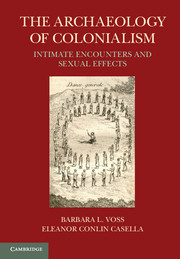Book contents
- Frontmatter
- Contents
- List of Illustrations
- List of Tables
- List of Contributors
- One Intimate Encounters
- Two Sexual Effects
- Section I Pleasures and Prohibitions
- Three Little Bastard Felons
- Four The Currency of Intimacy
- Five “A Concubine is Still a Slave”
- Six The Politics of Reproduction, Rituals, and Sex in Punic Eivissa
- Section II Engaged Bodies
- Section III Commemorations
- Section IV Showing and Telling
- Conclusion
- Index
- References
Five - “A Concubine is Still a Slave”
Sexual Relations and Omani Colonial Identities in Nineteenth-Century East Africa
from Section I - Pleasures and Prohibitions
Published online by Cambridge University Press: 05 June 2012
- Frontmatter
- Contents
- List of Illustrations
- List of Tables
- List of Contributors
- One Intimate Encounters
- Two Sexual Effects
- Section I Pleasures and Prohibitions
- Three Little Bastard Felons
- Four The Currency of Intimacy
- Five “A Concubine is Still a Slave”
- Six The Politics of Reproduction, Rituals, and Sex in Punic Eivissa
- Section II Engaged Bodies
- Section III Commemorations
- Section IV Showing and Telling
- Conclusion
- Index
- References
Summary
Introduction
Concubinage, in which women were enslaved for the purpose of sexual relations with their male owners outside the institution of marriage, was an integral part of nineteenth-century Islamic colonial Zanzibari society. Initially, I aimed to identify concubinage within the archaeology of a nineteenth-century Zanzibari clove plantation, but archaeological materials did not simply proclaim their connections to sexuality. It is no easy task for an archaeologist to identify material traces of the many women who were enslaved to be forced into sexual relations and/or for reproduction. The interpretations presented here thus draw both on archaeological evidence and on my conversations about former plantation residents with contemporary Zanzibaris, in the process of which I was confronted with the historical reality of concubinage. I have also had to grapple with the politics and ethics of writing a scholarly paper that examines the subjectivities of enslaved women who were forced into sexual relations with their owners, an oppressive relationship that paradoxically may have offered a route to their greatest potential material well-being and eventual freedom.
Both of these topics have yet to be discussed by archaeologists working along the East African “Swahili” coast, where historical and archaeological analyses of houses are generally interpreted as structured by Islamic gender dichotomies (Donley-Reid 1990; Fleisher and LaViolette 2007; Horton and Middleton 2000; Sheriff 1995a, 1995b). The most recent scholarship, focused on urban Zanzibar, has blurred such strict dichotomies by examining the intersections of class and gender within East African house space (Myers 1997). Separate from these materially focused studies, historians of gender on the East African coast have shown that sexual relations between husbands and wives and masters and concubines were an important aspect through which women mediated ethnic and class relations (Fair 1996; McCurdy 2006). This chapter draws together these two strands of scholarship. Focusing on the material remains of nineteenth-century rural clove plantations on Zanzibar, I explore the way in which sexual relations were embedded in spatial practices of households.
- Type
- Chapter
- Information
- The Archaeology of ColonialismIntimate Encounters and Sexual Effects, pp. 67 - 84Publisher: Cambridge University PressPrint publication year: 2011
References
- 5
- Cited by

